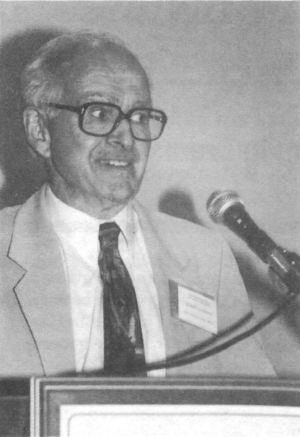Auschwitz: Facts and Legend
Robert Faurisson is Europe's leading Holocaust revisionist scholar. He was educated at the Paris Sorbonne, and served as a professor at the University of Lyon in France from 1974 until 1990. He was a specialist of text and document analysis. After years of private research and study, Dr. Faurisson first made public his skeptical views about the Holocaust extermination story in articles published in 1978 and 1979 in the French daily 1£ Monde. His writings on the Holocaust issue have appeared in two books and numerous scholarly articles, many of which have been published in this Journal.
This essay was originally written in early 1995 for El Mundo, a leading Spanish newspaper. However, after the text had been authorized, translated into Spanish, and set in type, the newspaper suddenly decided not to publish it.
At the beginning of 1940, Auschwitz was no more than a town of 13,000 population in German Upper Silesia. Then, in May of 1940, on the outskirts of Auschwitz, construction of a “transit camp” for 10,000 Polish prisoners was begun at the site of a former artillery barracks of the Polish army.
In the years that followed, and with the worsening of the war, Auschwitz thereupon became the center of a complex of nearly 40 camps and subsidiary camps, as well as the capital of a vast agricultural and industrial complex (including mines, petrochemical works, and munitions factories) where numerous prisoners, particularly Polish and Jewish prisoners, worked side by side with civilian workers. At the same time, or successively, Auschwitz was a prisoner-of-war camp, an important transit camp, a hospital camp, a concentration camp, and a camp of both forced and free laborers. It was never an “extermination camp” (a term invented by the Allies).
However, typhus, which was endemic in the population of Polish Jews and Russian prisoners of war, along with typhoid fever and other epidemics, wrought havoc within the concentration camp population, both in the camps proper and in the town of Auschwitz, even among the German physicians and the civilian population. And this in spite of drastic hygienic measures and a multiplicity of hospital buildings and facilities, equipped at times with the latest in German medical science. Thus it came about that over the total period of the camp's existence – that is, from May 20, 1940 to January 18, 1945 – the epidemics, in combination to be sure with the terrible working conditions in that marshy area, and with hunger, heat and cold, led to the death of probably 150,000 prisoners.[1]
The Auschwitz Rumor
As is usual in time of war and in wartime propaganda, many rumors sprang up in the wake of these tragic events. Above all toward the end of the war, and especially in Jewish circles outside of Poland, people began to spread tales to the effect that in Auschwitz the Germans were killing millions of prisoners systematically on orders from Berlin. According to these rumors, the Nazis had installed “death factories” for the Jews in particular; that they were dissecting prisoners alive (vivisection), or else burning them alive (in pits, in blast furnaces, or in crematories); or that, before burning them, they. were gassing the Jews in chemical slaughterhouses called “gas chambers.” Here were revived some of the myths of the First World War.[2]
The Quandary of the Soviet Liberators
Soviet forces occupied Auschwitz on January 27, 1945. What they found there was so contrary to what had been spread by propaganda that one may imagine they were left with mouths agape. Alone in its organization and in its sanitary facilities, so modern in the eyes of the Soviets, the camp was the complete opposite of an “extermination camp.” Consequently, for several days the leading Soviet daily Pravda remained silent, and, for the moment, no Allied commission of inquiry was invited to determine, on the spot, the truth of Auschwitz. On the 1st of February, Pravda broke its silence, but only to put the following words in the mouth of a single prisoner:
The Hitlerites killed the children and the ill by means of gas, as well as the men and women who were unfit for work. They cremated the cadavers in special furnaces. There were twelve of these furnaces in the camp.
The official Soviet paper added that the number of deaths was reckoned at “thousands and thousands” (not millions). The next day, Pravda's chief reporter, Jewish journalist Boris Polevoi, affirmed that the main method used by the Germans to exterminate their victims was … electricity:[3]
[They utilized] an electric conveyor belt on which hundreds of persons could be electrocuted simultaneously; the dead bodies would then fall on to a belt driven slowly by a chain and in this way move on into a blast furnace.
Soviet propaganda was in disarray, and in its newsreels could show only the dead or dying whom the Germans had left behind in their retreat. And, as contemporary newsreels of the camp's liberation reveal, there were also numerous live children, as well as adults in good health. Jewish propaganda then came to the aid of Soviet propaganda.
Jewish Propaganda at the End of 1944
In the spring of 1944, two Jewish escapees from Auschwitz had found refuge in Slovakia. There, with the aid of co-religionists, they began to put together a history of Auschwitz, Birkenau (subsidiary camp of Auschwitz), and Majdanek, three camps they described as “extermination camps.” The best known of these Jews was Walter Rosenberg, alias Rudolf Vrba, who is still alive today, residing in British Columbia, Canada. Their highly fanciful story then spread, always by way of Jewish circles, into Hungary, Switzerland, and finally to the United States. It took the form of a typewritten report published in the United States in November of 1944 by the War Refugee Board, under the official stamp of President Roosevelt. The War Refugee Board (WRB) owed its creation to Henry Morgenthau, Jr. (1891-1967), the Secretary of the Treasury who was later to become famous for the “Morgenthau Plan,” which, had it been followed by Roosevelt and Truman, would have resulted in the physical annihilation, after the war, of millions of Germans.
The WRB report served as the model for the official “truth” concerning Auschwitz. The Soviets took it as a pattern for their own official Commission report of May 6, 1945, which the Nuremberg Tribunal deemed to have “probative value.” Along with the Soviet Commission report on the Katyn massacre, the Tribunal took “judicial notice” of the Soviet report on Auschwitz, which meant that it could not be questioned. According to this report (Nuremberg document USSR-008), the Germans had killed more than four million people at Auschwitz, notably by gassing them with the insecticide known as “Zyklon B.” This official “truth,” at least regarding the number of victims, was to collapse in 1990.
The Confession of Rudolf Höss
On April 15, 1946, one of the three successive commanding officers of Auschwitz, Rudolf Höss (not to be confused with Rudolf Hess), “confessed” under oath before the Nuremberg judges and before reporters of the world press that during the time of his command, that is from May 20, 1940, to December 1, 1943, at least 2,500,000 prisoners in Auschwitz had been executed by gas, and that at least another 500,000 had died of famine and disease, thus making a total of at least 3,000,000 deaths during that period alone.[4] But not for a moment was Höss interrogated or cross-examined on the material specifics of the extraordinary facts he reported. After testifying at Nuremberg, he was turned over to the Poles. Under the supervision of his Communist jailers, he wrote a penciled confession in due and proper form, after which he was hanged at Auschwitz on April 16, 1947. Curiously, it was not until 1958 that a portion of this confession was made public, under the title Kommandant in Auschwitz.[5]
Physical-Chemical Impossibilities
The extremely vague and hurried description of the operation of gassing prisoners, as provided by Höss in his written confession, is impossible for both physical and chemical reasons. An execution gassing is not to be confused with a suicidal or accidental gassing: in an execution gassing, the aim is to kill without being killed or poisoned.
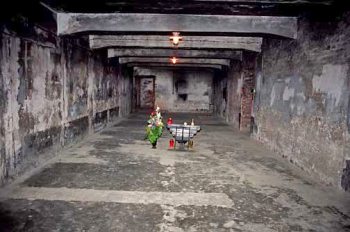
For decades this room in the Auschwitz I camp has been shown to tens of thousands of tourists yearly as a execution “gas chamber” in its “original state.” In January 1995 the prominent French weekly “L'Express” acknowledged that “everything is false” about this “gas chamber,” which is actually a postwar reconstruction.
Zyklon B is an insecticide with a hydrocyanic acid base that has been widely used since 1922, and is still in use today. It is extremely dangerous. It adheres to surfaces. It is difficult to dispel. It is explosive. In a few states in the USA, hydrogen cyanide gas is used to execute prisoners who have been condemned to death. An execution gas chamber is necessarily very sophisticated, and the procedure is protracted and dangerous. But in his confession, Höss said that the work crew charged with removing 2,000 corpses at a time from a gas chamber entered the area as soon as a ventilator had been turned on, and set about their Herculean task while eating and smoking; that is to say, if we understand correctly, without even a gas mask. Impossible. No one could have gone into an ocean of hydrocyanic acid like that and handled thousands of cyanide-contaminated corpses, which were untouchable because they were impregnated with a highly lethal poison that can kill on contact. The task would have been impossible, even using gas masks with a special filter for hydrogen cyanide, because the filters could not have stood up under the heavy breathing caused by a physical effort of even feeble intensity.
A Response by 34 Historians
In the issues of the French daily Le Monde of December 29, 1978, and of January 16, 1979, I briefly set forth the reasons why, knowing the locations and the alleged procedure followed, I considered that the Auschwitz gassings were technically impossible. On February 21, 1979, again in Le Monde, there appeared a declaration by 34 French historians that concluded as follows: “We need not ask ourselves how such a mass murder was technically possible. It was technically possible since it took place.” In my opinion, the “exterminationists,” as I call them, at that point signed their capitulation. From the point of view of science and of history, the myth of the Nazi gas chambers had received a fatal blow. No exterminationist work since then (or before) has provided any explanation of the matter, most especially not the work by Jean-Claude Pressac that is fallaciously titled Auschwitz: Technique and Operation of the Gas Chambers.[6] To begin with, the time is past when historians dare to claim authenticity for “gas chambers” at Auschwitz or elsewhere that are presented to tourists as being “in its original condition,” “in a restored state,” or “in a state of ruin” (ruins can be most eloquent). The alleged gas chambers of Auschwitz were simply cold rooms for the storage of cadavers awaiting cremation, just as the plans which I discovered in 1976 attest.
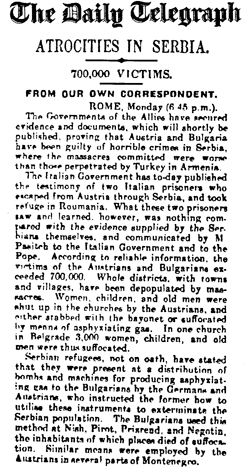
During the First World War, Allied propagandists charged that Austrians and Bulgarians (allies of Germany) killed Serb civilians by gassing them in churches. This article (facsimile) from the London Daily Telegraph, March 22, 1916, p. 7, tells readers that 3,000 women, children and old men were gassed in one church in Belgrade alone.
'Show Me or Draw Me …'
In March of 1992, I issued a challenge in Stockholm directed to the world at large: “Show me or draw me a Nazi gas chamber!” I stated explicitly that I was not interested in a building reputed to contain such a gas chamber, nor in a section of a wall, nor in a door, nor in hair, nor in shoes. I wanted to see a complete representation of the weapon of the crime, of its technical specifications, of its operation. I added that, if it is alleged that the Germans had destroyed the weapon, then someone would have to make me a drawing of it. I refused to believe in a “material reality” devoid of any material representation.
The Holocaust Memorial Museum
On August 30, 1994, I visited the Holocaust Memorial Museum in Washington, DC. There I found no physical representation of the magical gas chamber. I then asked Michael Berenbaum, the Museum's Research Director, in the presence of four witnesses in his office, to explain this anomaly to me. After becoming violently angry, he finally replied that “the decision had been made not to present any physical representation of a Nazi gas chamber”! He did not bother to mention that in the Museum there was an artistic model of Birkenau's Crematory II, with its supposed “gas chamber.” He knew that the model in question, which for that matter he didn't reproduce in his guide book of the Museum,[7] was just an artistic creation that bore no relation to reality.
The Exterminationist Fiasco
On that occasion I reminded Berenbaum of some events that had been disastrous for the exterminationist cause:
In 1968, French-Jewish historian Olga Wormser-Migot acknowledged in her thesis that there was a “problem with the gas chambers.” She also wrote that the Auschwitz I main camp was “without a gas chamber” (notwithstanding the “gas chamber” there visited by millions of tourists).[8]
In 1983, a British author, even though he was a defender of the extermination legend, revealed how Rudolf Höss, prior to his testimony before the Nuremberg Tribunal, had been tortured by Jewish members of British Military Security, and had confessed only after being kicked and punched, exposed to cold and deprived of sleep.[9]
In 1985, at the first trial of Ernst Zündel in Toronto, both the number one prosecution witness, Rudolf Vrba, and the number one historian of the exterminationist thesis, Raul Hilberg, completely broke down under cross-examination by defense attorney Douglas Christie, with my assistance.[10]
In 1988, the American Jewish historian Arno Mayer, albeit while asserting his belief in the genocide and in the gas chambers, wrote: “Sources for the study of the gas chambers are at once rare and unreliable … Besides, from 1942 to 1945, certainly at Auschwitz, but probably overall, more Jews were killed by so-called 'natural' causes [starvation, disease, sickness, and overwork] than by 'unnatural' ones.”[11]
In 1992, Yehuda Bauer, a professor at the Hebrew University of Jerusalem and a prominent Holocaust historian, authoritatively reassessed the role of the well known “Wannsee Conference” of January 20, 1942. The often-repeated claim that the decision to exterminate the Jews was made at that meeting is “silly,” he said.[12]
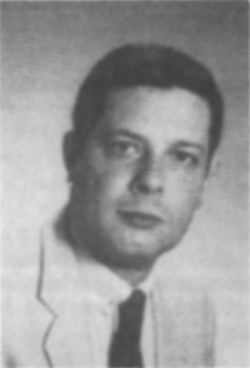
Jean-Claude Pressac
In 1993, Pressac estimated the number of deaths at Auschwitz (Jews and non-Jews) at a total of 775,000, and, then, in 1994, at a figure somewhere between 630,000 and 710,000.[13]
In that same year, Professor Christopher Browning, contributor to the Encyclopedia of the Holocaust, stated: “Höss was always a very weak and confused witness.” He then had the gall to add: “The revisionists use him all the time for this reason, in order to try to discredit the memory of Auschwitz as a whole.””[14]
Until the beginning of 1990 any visitor to Auschwitz could see, inscribed in 19 different languages on 19 metal plaques on the large monument of Birkenau, words proclaiming that four million people had died in the camp. But around April of 1990 those plaques were removed by the Auschwitz Museum authorities, who still today do not know what figure to put in place of the numerical lie before which the world's most prominent figures, including Pope John Paul II, have come to bow their heads.
In support of their thesis, the revisionists have at their disposal the reports of three different experts (Fred Leuchter, Germar Rudolf, Walter Lüftl) and even the beginnings of a Polish expert's report, whereas the exterminationists still do not dare to seek an expert report on the alleged weapon of the crime.
The Jewish survivors of Auschwitz and, in particular, the “children of Auschwitz,” that is, those who were born in the camp or who spent their early years there, are living proof that Auschwitz never could have been an “extermination camp.”
Not only was there never any order, plan, or trace of any directive or budget for an undertaking as enormous as the systematic extermination of the Jews would have been, not only is there no autopsy report in existence establishing the death of even a single prisoner by poison gas, or an official expert's report on the weapon used in the crime, but (and despite what some authors of best sellers would have us believe) there is not even a single witness of the gas chambers.
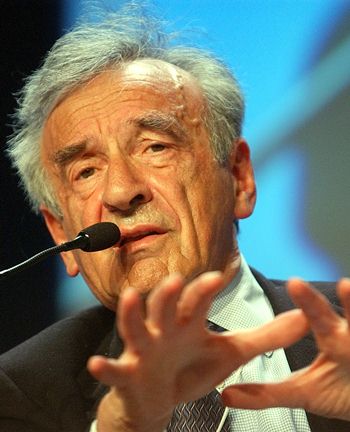
Elie Wiesel. In his autobiographical work “Night” he relates that in January 1945, as a prisoner at Auschwitz, he and his father were given the choice of remaining behind in the camp to await the imminent arrival of Soviet liberators, or to leave with their German captors. After discussing the matter, father and son decided to leave with their “exterminators.”
Elie Wiesel, in his autobiographical testimony Night, published in 1958, does not mention the gas chambers of Auschwitz even once. He says that the Jews were exterminated in huge fires or in crematory furnaces! In January of 1945 the Germans gave him and his father as well the choice of leaving for the heart of Germany with them or of waiting on the spot for the Soviets. After due consideration, the father and son decided to flee with their German “exterminators” rather than wait for their Soviet liberators. All this is clearly spelled out in Night, and needs only to be read with attention.[15]
The Auschwitz Lie
In 1980, I announced: “Now, please pay heed! Not one of the 60 [in French] words of the sentence I am going to pronounce is motivated by a political opinion: The alleged genocide of the Jews and the alleged Hitler gas chambers form one and the same historical lie that has permitted a gigantic political-financial swindle in which the principal beneficiaries are the State of Israel and international Zionism, and the principal victims the German people but not their rulers – and the entire Palestinian people.”
I do not see a single word in that declaration that I would withdraw today, in spite of the physical aggressions, in spite of the lawsuits, in spite the fines I have suffered since 1978, and in spite of the imprisonment, exile, or persecution of so many revisionists. Historical revisionism is the great intellectual adventure of the end of this century. I have but one regret: not being able, within the limits of this article, to find the needed space to render homage to the hundred other revisionist authors who, from the Frenchman Paul Rassinier on through the American Arthur Butz, the German Wilhelm Stäglich, the Italian Carlo Mattogno, and the Spaniard Enrique Aynat, have added so many works of striking merit to the historical reality of the Second World War.
One final word: the revisionists are neither deniers nor persons animated by sinister purposes. They seek to tell what has happened and not what has not happened. They are matter-of-fact. What they report is good news. They continue to propose a public debate in the full light of day, even though, up to now, they have been answered principally by insults, by violence, by the unjust force of the law, or else by vague political, moral, or philosophical considerations. Among historians, the legend of Auschwitz must give way to the factual truth.[16]
— January 11, 1995
Notes
| [1] | This figure of 150,000 deaths perhaps equals the number of those killed in what has been called the world's greatest “crematory for the living” – that of the bombing of Dresden, “Florence on the Elbe,” 'in February 1945 by British and American airmen. |
| [2] | During the First World War the Allies accused the Germans of using churches as gas chambers and of operating cadaver factories. On the first point, see “Atrocities in Serbia. 700,000 Victims,” The Daily Telegraph (London), March 22, 1916, p. 7. This same paper reported similar charges during the Second World War. See: “Germans Murder 700,000 Jews in Poland. Travelling Gas Chambers,” The Daily Telegraph, June 25, 1942, p. 5. (See also: R. Faurisson, “A Request for Additional Information on the Myth of the 'Gassing' of the Serbs in the First World War,” Summer 1991 Journal, pp. 254-255.) |
| [3] | Report by B. Polevol,Pravda, Feb. 2, 1945, p. 4. I first learned of this article while doing research in 1979 in the National Archives, Suitland (Maryland) branch, when I came across a brief report from the Washington (DC) Daily News of Feb. 2, 1945, pp. 2, 35 (“'Ageless, Sexless Ghosts' Rescued From Murder Mill,” United Press dispatch by Henry Shapiro from Moscow), which was based, more or less, on the Pravda article. |
| [4] | International Military Tribunal, Trial of the Major War Criminals Before the International Military Tribunal (IMT “blue series”), Nuremberg: 1947-1949, Vol. 11, pp. 414-415. |
| [5] | Stuttgart: Deutsche Verlags-Anstalt, 1958. To his shame, the person responsible for this publication was Martin Broszat. |
| [6] | Jean-Claude Pressac, Auschwitz: Technique and Operation of the Gas Chambers (New York: Beate Klarsfeld Foundation, 1989). On the work of Pressac, see the reviews and critical responses that have appeared in this Journal: M. Weber in Vol. 10, No. 2 (Summer 1990), pp. 231 – 237; C. Mattogno in Vol. 10, No. 4 (Winter 1990-91), pp. 461-485; R. Faurisson in Vol. 11, No. 1 (Spring 1991), pp. 25-66, and in Vol 11, No. 2 (Summer 1991), pp. 133-175; A. Butz in Vol. 13, No. 3, (May-June 1993), pp. 23-37; S. Thion in Vol. 14, No. 4 (July-August 1994, pp. 28-39. |
| [7] | M. Berenbaum, The World Must Know: The History of the Holocaust As Told in the US Holocaust Memorial Museum (Boston: Little, 1993), pp. 137-143. |
| [8] | O. Wormser-Migot, Le Systeme concentrationnaire nazi (1933-1945) (Presses Universitaires de France, 1968), pp. 157,541-545. Eight days after this essay was written, the prominent French weekly L'Express acknowledged that, as Robert Faurisson had said “at the end of the 70s,” “everything is false” about the Auschwitz I “gas chamber” that for decades has been shown to tens of thousands of tourists yearly. (See “Major French Magazine Acknowledges Auschwitz Gas Chamber Fraud,” Jan.-Feb. 1995 Journal, p. 23.) |
| [9] | Rupert Butler, Legions of Death (London: Arrow, 1983), acknowledgments page and pp. 234-238. |
| [10] | Barbara Kulaszka, compiler and editor, Did Six Million Really Die?: Report of the Evidence in the Canadian “False News” Trial of Ernst Zündel, 1988 (Toronto: Samisdat Publishers, 1992); see the index listings “Vrba, Rudolf” and “Hilberg, Raul.” |
| [11] | Arno Mayer, The “Final Solution” in History (New York: Pantheon, 1988), pp. 362, 365. |
| [12] | “Wannsee's importance rejected,” Jewish Telegraphic Agency dispatch, The Canadian Jewish News, January 30, 1992. |
| [13] | J.-C. Pressac, Les Crématoires d'Auschwitz (CNRS editions, 1993), p. 148; J.-C. Pressac, Die Krematorien von Auschwitz (München: Piper Verlag, 1994), p. 202. “From 600,000 to 800,000,” wrote J.-C. Pressac in “La Technique des chambres à gaz,” an article included in La Déportation: Le Système concentrationnaire nazi, a book published under the direction of François Bedarida (BDlC: 1995), p. 196. |
| [14] | Christopher Hitchens, “Whose History is It?,” Vanity Fair (New York), December 1993, p. 117. |
| [15] | E. Wiesel, Night (Avon/Discus pb. edition), pp. 41, 42, 43, 44, 79, 93. (French edition: La Nuit, editions de Minuit, 1958, pp. 128-130). In the German edition (Die Nacht zu begraben, Elischa [Ullstein, 1962]), the word “crematory,” “crematories” or “crematory ovens” has been systematically replaced with the term “gas chamber” or “gas chambers” (in German: Gaskammer[n].) Embarrassed about the gas chambers, Wiesel wrote in his 1994 memoir: “Let the gas chambers remain closed to prying eyes, and to imagination.” English language version: All Rivers Run to the Sea (New York: Knopf, 1995), p. 74. The words that follow show that Wiesel does not believe the “testimonies” of Filip Müller and others like him who, supposedly, have described what happened in the gas chambers. |
| [16] | For revisionist publications in French, contact RHR ([…defunct by now; ed.]), and for those in English or in German, contact Samisdat Publishers ([…defunct by now; ed.]) or the Institute for Historical Review. |
Corrections:
In the July-August 1995 issue of The Journal of Historical Review, there is an error in footnote 28 on page 7. The letter cited from the Los Angeles Times, July 27, 1995, was actually written by Richard M. Walden of Los Angeles.
In the May-June 1997 Journal, p. 33, we reported on a statement by 21 Italian scholars defending freedom of speech and of historical research on the Holocaust issue. This statement was published in the Turin daily paper La Stampa of March 1, 1995 (not 1996).
“In showing concern for future one must regard the past with reverence and the present with mistrust.”
—Joseph Joubert (1754-1824), French philosopher
Bibliographic information about this document: The Journal of Historical Review, vol. 16, no. 4 (July/August 1997), pp. 14-19
Other contributors to this document: n/a
Editor’s comments: original written on January 11, 1995.

